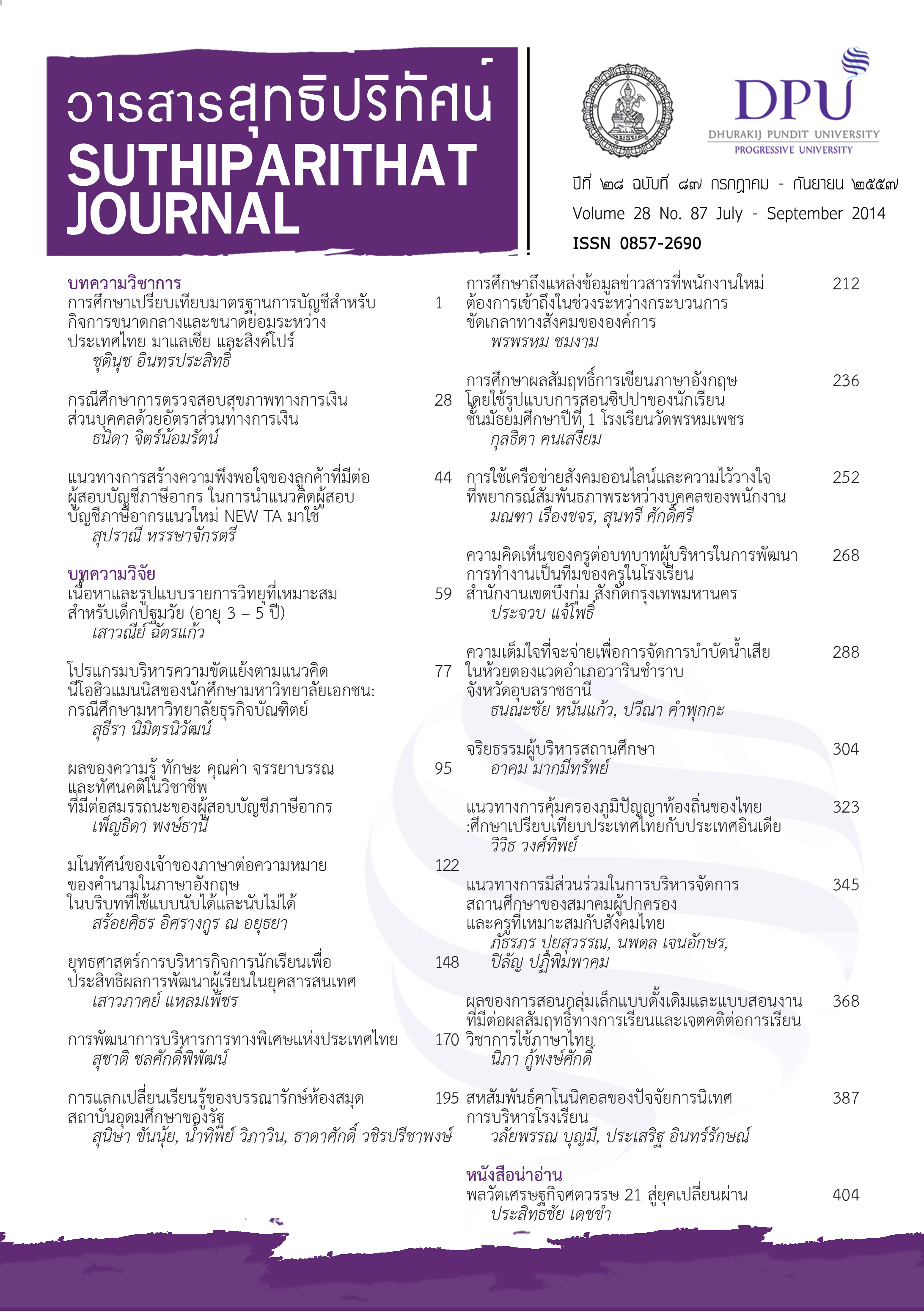มโนทัศน์ของเจ้าของภาษาต่อความหมายของคำนามในภาษาอังกฤษในบริบทที่ใช้แบบนับได้และนับไม่ได้
คำสำคัญ:
การนับได้ของคำนาม, คำนามที่ใช้เรียกสิ่งที่เป็นรูปธรรม, คำนามที่ใช้เรียกสิ่งที่เป็นนามธรรมหรืออาการนาม, สามารถแบ่งแยกออกเป็นปัจเจก, ไม่สามารถแบ่งแยกออกเป็นปัจเจกบทคัดย่อ
งานวิจัยเชิงคุณภาพเรื่องนี้ศึกษามโนทัศน์ของเจ้าของภาษาต่อการนับได้ของคำนาม โดยมุ่งที่จะตรวจสอบการเปลี่ยนแปลงของความหมายเมื่อคำนามเปลี่ยนสถานะจากการเป็นนามนับได้เป็นนามนับไม่ได้หรือในทางตรงข้าม บทนำเริ่มจากการทบทวนวรรณกรรมเชิงทฤษฎีที่เกี่ยวกับความแตกต่างระหว่างคำนามนับได้และคำนามนับไม่ได้ในภาษาอังกฤษ รวมถึงความแตกต่างของความหมายในเชิงอรรถศาสตร์และหน่วยคำของระบบคำนามในภาษาอังกฤษและภาษาไทย ตอนที่สองอภิปรายการศึกษาวิจัยซึ่งสำรวจมโนทัศน์ของเจ้าของภาษาอังกฤษต่อการนับได้ของคำนามที่ใช้กับคำนำหน้านามที่แตกต่างกันในบริบทต่างๆ ตอนที่สามนำเสนอผลจากการวิจัยเชิงคุณภาพซึ่งมุ่งที่จะตรวจสอบทฤษฎีที่กล่าวอ้างไว้ในวรรณกรรม (อาทิเช่น Alan, 1980; Baldwin & Bond, 2003; Mufwene, 1984; Wierzbicka, 1988) ตอนสุดท้ายเป็นการสรุปผลการวิจัยที่แจกแจงเป็นข้อสรุปจากผลการวิเคราะห์พร้อมทั้งข้อเสนอแนะสำหรับการวิจัยในครั้งต่อไป ผู้วิจัยหวังว่างานวิจัยชิ้นนี้จะอำนวยประโยชน์ให้แก่ผู้สอนภาษาอังกฤษในการพัฒนาการเรียนการสอนและการเตรียมเนื้อหาวิชาที่เหมาะสมเพื่อสอนให้ผู้เรียนรู้จักการนำบริบทมาใช้ในการพิจารณาการนับได้ของคำนามในภาษาอังกฤษได้อย่างถูกต้อง
เอกสารอ้างอิง
Baldwin, T., & Bond, F. (2003). Learning the countability of English nouns from corpus data. In the Proceedings of the 41st Annual Meeting on Association for Computational Linguistics (pp. 463-470). Association for Computational Linguistics, Morristown, NJ, USA.
Hua, D., & Lee, T.H. (2005). Chinese ESL learner’ understanding of the English count-mass distinction. In Proceedings of the 7th Generative Approaches to Second Language Acquisition Conference (pp. 138-149). Somerville, MA, USA.
Katz, G., & Zamparelli, R. (2012). Quantifying count/mass elasticity. In the Proceedings of the 29th West Coast Conference on Formal Linguistics (pp. 371-379)
Langacker, R. (1987). Nouns and verbs. Language, 63(1), 53-94.
Leech, G., & Svartvik, J. (1994). A communicative grammar of English, Second Edition. London: Longman.
Master, P. (1988). Teaching the English article system. English Teaching Forum, 26(2), 2-7.
Master, P. (1990). Teaching the English articles as a binary system. TESOL Quarterly, 24, 461-478.
Master, P. (2002). Information structure and English article pedagogy. System, 30(3), 331-348.
Mufwene, S. (1984). The count/mass distinction and the English lexicon. In D. Testen, V. Mishra, & J. Drogo (Eds.). Lexical Semantics. Chicago: Chicago Linguistic Society.
Quirk, R., Greenbaum, S. & Svartvik, J. (1979). A Grammar of Contemporary English. London: Longman.
Wierzbicka, A. (1988). The Semantics of Grammar. Amsterdam: John Benjamins.
Yoon, K.K. (1993). Challenging prototype descriptions: Perception of noun countability and indefinite vs. zero article use. IRAL, 31, 269-289.
Young, R. (1996). Form-function relations in articles in English interlanguage. In R. Bayley & D.R. Preston (Eds.): Second Language Acquisition and Linguistic Variation (pp. 135-175). Amsterdam: John Benjamins.
ดาวน์โหลด
เผยแพร่แล้ว
รูปแบบการอ้างอิง
ฉบับ
ประเภทบทความ
สัญญาอนุญาต
เนื้อหาและข้อมูลในบทความที่ลงตีพิมพ์ในวารสารสุทธิปริทัศน์ ถือเป็นข้อคิดเห็นและความรับผิดชอบของผู้เขียนบทความโดยตรงซึ่งกองบรรณาธิการวารสาร ไม่จำเป็นต้องเห็นด้วย หรือร่วมรับผิดชอบใด ๆ
บทความ ข้อมูล เนื้อหา รูปภาพ ฯลฯ ที่ได้รับการตีพิมพ์ในวารสารสุทธิปริทัศน์ ถือเป็นลิขสิทธิ์ของวารสารสุทธิปริทัศน์หากบุคคลหรือหน่วยงานใดต้องการนำทั้งหมดหรือส่วนหนึ่งส่วนใดไปเผยแพร่ต่อหรือเพื่อกระทำการใด ๆ จะต้องได้รับอนุญาตเป็นลายลักษณ์อักษรจากวารสารสุทธิปริทัศน์ก่อนเท่านั้น







